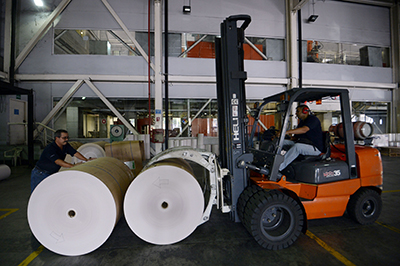Venezuelan newspapers have traditionally handed out hundreds of courtesy copies in their lobbies and at hotels. But Correo del Caroní, an independent daily in the industrial city of Ciudad Guayana, treats every edition as if it were precious and now gives away just 14 copies, including one to the owner.
Curtailing freebies is one way Correo del Caroní is adjusting to a critical shortage of newsprint in Venezuela. The newspaper now circulates just five days a week instead of seven and has cut back to just eight pages. Stories, photographs and headlines have all shrunk.
“It’s a huge challenge,” night editor Leonardo Suárez Montoya told CPJ. “How do you say what you have to say with less space?”
It’s a challenge that the print media across Venezuela have been facing for the past two years. The country imports its newsprint from Canada and the U.S., but due to the socialist government’s currency controls, it can take many months for newspaper companies to secure the dollars required to buy newsprint. Adding to the delays, the government in 2012 removed newsprint from its list of fast-track “priority” imports.
The Caracas-based Institute for Press and Society (IPYS) reported that between September 2013 and August 2014, 34 newspapers and magazines in 11 states had encountered difficulties securing newsprint. Some reduced their size or eliminated sections. The IPYS report stated that due to the newsprint shortage, six newspapers had closed and four others had temporarily stopped printing. That prompted the popular English-language blog Caracas Chronicles to declare that “newsprint-geddon is just around the corner.”
Until recently, most Venezuelan newspapers purchased newsprint from several import companies. But this year President Nicolás Maduro’s government moved to centralize imports through the newly created Alfredo Maneiro Editorial Corporation, a state-run enterprise. This development is fueling concerns among journalists that newspapers with critical voices could be denied access to newsprint or provided with limited quantities, according to Marco Ruíz, secretary general of the National Union of Press Workers.
Ruíz and other analysts see the newsprint shortage as a strategy by the Maduro government to strangle newspapers, which are some of the only independent news outlets left in Venezuela. Fearing backlashes or advertising boycotts, most Venezulean TV and radio stations now shy away from criticizing the government. In the past two years several major media outlets have been sold to new owners on friendly terms with the government and have softened their coverage.
“The government would be very happy if we disappeared or sold out,” Oscar Murillo, the managing editor of Correo del Caroní, told CPJ. “But our goal is to keep publishing.”
It is a crucial mission because among the nine daily newspapers published in Ciudad Guayana and the surrounding state of Bolívar, Correo del Caroní is the only one that continues to serve as a kind of government watchdog, Damián Prat, a veteran local print and radio journalist, told CPJ.
Recent stories included how patients were dying in public hospitals due to the lack of doctors, and reports on strikes at state-run SIDOR, Venezuela’s largest steel mill which is in Ciudad Guayana. The labor conflicts were largely ignored by other local news media that have a pro-government editorial line, according to Prat, a columnist for Correo del Caroní.
But boiling a daily newspaper down to eight pages can be painful. State-run entities, which are the backbone of the local economy, did not advertise in Correo del Caroní due to its criticism of the government, Murillo said, but some private-sector advertising was lost when the paper downsized.
News beats that used to merit a full page of daily coverage–such as stories from the nearby city of Ciudad Bolivar–now receive quarter of a page or less, Suárez said. He often rewrites anecdotal ledes to get straight to the point and save space. Even the most dramatic photos are reduced in size or go unprinted. Sub-heads that give context to headlines have been largely eliminated. But Suárez refuses to complain.
“If doctors don’t have enough medical supplies, they don’t stop treating their patients,” Suárez said. “We have to work even harder. People have the right to information and to be well-informed.”
Stories that don’t fit in the printed paper are published on the newspaper’s website. But many people in Ciudad Guayana lack Internet connections in their homes due to the high cost and spotty service, said Alba Perdomo Bermudez, a former news editor at Correo del Caroní who is now an IPYS consultant. Wireless Internet in public areas is rare. And although smart phones are becoming more popular, Perdomo said, many owners do not like reading newspapers on such small devices. That’s why she said people in Ciudad Guayana still prefer to read their news on paper.
Although Correo del Caroní has maintained its tradition of feisty news coverage, Perdomo says there is no denying that it is a diminished product. When she worked at the paper a few years ago it published 32 pages per day.
“With just eight pages the newspaper loses a lot of voices, a lot of stories, and a lot of exposés,” she said.
